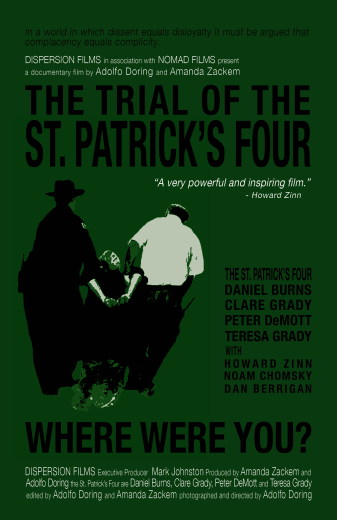
Some timely court testimony from Daniel Burns, of the St. Patrick’s Day Four, charged with trespassing after pouring his blood in a military recruitment center in 2003 before the impending Iraq invasion:
“I poured blood carefully. I didn’t throw it or splash it; exaggerations. And it dropped down. And then I saw the flag; I poured it on the flag. And then I went over to the literature and I poured it on the literature and I poured it on cutouts I saw in the corner. And then I went to the front window and I poured blood on a sign that said $50,000 for college, $10,000 bonus sign on. And then I wondered why we just can’t give them money for college and we have to risk them, our precious soldiers, precious children, why do we have to send them to war to give them college education? In that room, in all that literature, there’s not one mention of blood. There’s no one mention of shedding blood.
…
Well, I’m Catholic and it’s part of our ceremony, the blood of Christ. Blood tells the truth very quickly. It tells the truth about war, and we were about to invade another country, and symbolically the use of blood in my religion, and it gets through all–it gets right to the heart. You know, when you see blood, it brings truth, and I want to bring truth about the war, and again, in that recruiting center there’s no mention of blood.”
Testimony from Sgt. Rachon Montgomery, who was at the recruiting office that day:
Pointing to a picture:
“That is the red substance, blood, that was splashed on the windows. The blood that was splashed on the windows. The blood that was on the door, as I was locking the door, some actually did get on me when I was locking the door.
Basically, I locked the door, took the key with me. You know, I had a conversation, if I’m not mistaken, with Mr. De Mott based on, you know, what is the point, what are you doing? And he said, you know, basically they were there for whatever their reasons were. Mr. Burns continued to splash whatever blood he had left. Then the two of them on that paper basically began to read prayers and poems and different things like that and at that point, I kind of realized I had blood on my hands. I went in the office so I was kind of , you know, getting upset…
Q: What were you upset about?
A: Well, I was upset that, you know, I had blood put on my hand, you know. I don’t know what type of diseases or anything so I was pretty upset about that. I was also upset they were actually there, you know, as we are trying to do our normal, you know, normal duties. Nobody comes to work to go through, you know, this type of event. So it kind–it was upsetting to have to go through that when I’m just there to do my job.“
*Cited in the very excellent essay “‘When you see blood, it brings truth’: Ritual and Resistance in a Time of War” by Elizabeth A. Castelli in Things: Religion and the Question of Materiality, edited by Dick Houtman and Birgit Meyer, 232-49. New York: Fordham University Press, 2012.